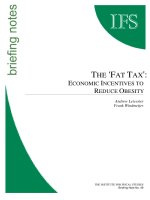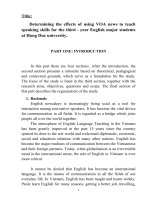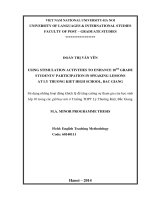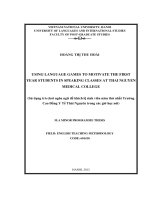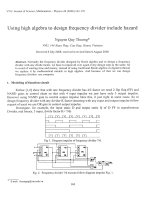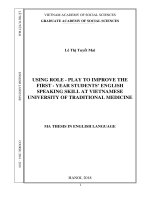species at risk using economic incentives to shelter endangered species on private lands
Bạn đang xem bản rút gọn của tài liệu. Xem và tải ngay bản đầy đủ của tài liệu tại đây (2.75 MB, 285 trang )
Species at Risk
00-T3053-FM 11/5/04 3:06 PM Page i
THIS PAGE INTENTIONALLY LEFT BLANK
Species at Risk
Using Economic Incentives to Shelter
Endangered Species on Private Lands
edited by jason f. shogren
University of Texas Press Austin
00-T3053-FM 11/5/04 3:06 PM Page iii
We gratefully acknowledge the financial support from the following sponsors at
the University of Wyoming: the Institute of Environment and Natural Resources,
the Bugas Fund, and the Stroock Professorship of Natural Resource Conservation
and Management.
Copyright © 2005 by the University of Texas Press
All rights reserved
Printed in the United States of America
First edition, 2005
Requests for permission to reproduce material from this work should be sent to
Permissions, University of Texas Press, P.O. Box 7819, Austin, TX 78713–7819.
᭺
ϱ
The paper used in this book meets the minimum requirements of ANSI /NISO
Z39.48–1992 (R1997) (Permanence of Paper).
Library of Congress Cataloging-in-Publication Data
Species at risk : using economic incentives to shelter endangered species on
private lands / edited by Jason F. Shogren — 1st ed.
p. cm.
Includes bibliographical references (p. ).
ISBN 0-292-70576-X (cloth : alk. paper)—
ISBN 0-292-70597-2 (pbk. : alk. paper)
1. Nature conservation—Economic aspects—United States. 2. Nature
conservation—United States—Citizen participation. 3. Endangered
species—United States. I. Shogren, Jason F.
QH76.S639 2005
333.95Ј2216Ј0973— dc22
2004010007
00-T3053-FM 11/5/04 3:06 PM Page iv
Foreword vii
mike sullivan and the members of the board of the Institute of
Environmental and Natural Resources, University of Wyoming
1. Introduction 1
jason f. shogren
PART I. Current and Proposed Incentive Options
for Species Protection on Private Lands
23
2. The Endangered Species Act and Its Current Set of Incentive Tools
for Species Protection 25
debra donahue
3. An Economic Review of Incentive Mechanisms to Protect Species
on Private Lands 65
gregory m. parkhurst and jason f. shogren
PART II. Challenges to Using Economic Incentives
for Species Protection
129
4. Endangered Species Protection and Ways of Life:
Beyond Economy and Ecology 131
frieda knobloch and r. mcgreggor cawley
5. A Critical Examination of Economic Incentives
to Promote Conservation 147
debra donahue
Contents
00-T3053-FM 11/5/04 3:06 PM Page v
6. Appraising the Conservation Value of Private Lands 173
steve w. buskirk and samantha m. wisely
7. Markets for Conserving Biodiversity Habitat:
Principles and Practice 191
thomas d. crocker
8. The Role of Private Information in Designing Conservation
Incentives for Property Owners 217
jason f. shogren, rodney b. w. smith,
and john tschirhart
PART III. Economic Incentives for ESA Reauthorization 233
9. Evaluating the Incentive Tools 235
gregory m. parkhurst and jason f. shogren
About the Authors 257
Index 259
vi Contents
00-T3053-FM 11/5/04 3:06 PM Page vi
Once a species has disappeared from the face of the earth, it doesn’t
come back. Extinction is irrevocable. This indisputable fact adds im-
portance and urgency to the work that Jason Shogren and colleagues
undertake in Species at Risk: Using Economic Incentives to Shelter En-
dangered Species on Private Lands. Correctly designed market incen-
tives can provide us with an efficient and effective set of tools to relieve
and redirect pressures that are leading to the extinction or endanger-
ment of species. By extension these same tools can enhance the habitat
and natural resource base on which the country’s social, economic, and
environmental vitality depend.
The Endangered Species Act (ESA) was conceived with the best of in-
tentions and, indeed, has many noteworthy achievements to its credit. It
is hard to argue with the preamble to the 1973 law that identifies the goal
of the legislation to conserve and protect “the ecosystems upon which
endangered and threatened species of wildlife depend.” Yet in practice
the law has too often become polarizing and, in the view of many
landowners and conservationists alike, provides perverse incentives that
can work against the protection of species, especially on private land.
Although many of the act’s provisions remain controversial, there is
widespread agreement that promoting and encouraging more effective
participation of private landowners in conservation efforts will result in
better conservation of threatened and endangered species, and perhaps
more important, help prevent species from getting to the point where
they are threatened in the first place. Numerous discussions have focused
on this subject: the board of the Institute of Environment and Natural
Resources (IENR) at the University of Wyoming devoted its spring 1996
forum to developing a series of principles to guide policy changes to the
Foreword
00-T3053-FM 11/5/04 3:06 PM Page vii
implementation of the ESA on private property, and the Keystone Cen-
ter completed a successful and broad-based dialogue identifying incen-
tives for private landowners to protect endangered species in July 1995.
Close to 90 percent of endangered species habitat is found on private
land. Any effort to conserve an endangered or threatened species or to
implement an ecosystem or landscape management strategy is more
likely to succeed if the private sector is a willing participant. Economic
incentives have proven effective and help to address the inequity of im-
posing the cost of preservation on a few for the benefit of the many, but
for some landowners those incentives may not go far enough. Shogren
and other researchers have put their finger on something deeply signifi-
cant to many landowners: they want their privacy respected, their prior
and current stewardship acknowledged, and flexibility in how they man-
age and care for their land and their investments in the future. Some re-
ject compensation outright for fear it will send a signal that they are not
already taking good care of their land, and because compensation might
invite excessive government scrutiny of activities in their own backyard.
When the IENR Board considered the ESA in 1996, it concluded:
“We must all look at new, creative, bold ways to build bridges with the
nation’s property owners and provide incentives to them for the protec-
tion of our natural resources.” This book is a direct response to that
challenge. Drawing on the disciplines of economics, law, political sci-
ence, history, and zoology, Species at Risk: Using Economic Incentives
to Shelter Endangered Species on Private Lands critiques several of the
approaches to species protection with proven records of success, includ-
ing habitat conservation plans, safe harbors, and no-surprise policies.
The book goes a step farther, however, in identifying the limits to
those approaches, suggesting additional market-based tools that could
be applied to address the privacy concerns of certain landowners and,
ultimately, increase the level of species conservation. In particular, the
book makes a case for consideration of a market for tradable critical
habitat rights, where landowners would be provided the opportunity to
sell private shares of critical habitat rights on an open market.
These approaches, to be certain, are not without controversy. Some
may question whether the approach affords adequate accountability of
public funds expended to purchase habitat conservation measures on
private lands. Others may argue that compensation of any sort is a back-
door attempt to sabotage the ESA through underfunding. To be sure,
numerous technical and legal obstacles remain before such an approach
could be applied, including how to measure the quality and quantity of
viii Mike Sullivan et al.
00-T3053-FM 11/5/04 3:06 PM Page viii
habitat and assign it a fair market value; but this is the kind of thinking
that holds potential for adding another important instrument, alongside
government compensation, land trusts, purchase of development rights,
technical assistance, insurance programs, and tax breaks, to build the
right set of incentives for species protection.
Checking our proverbial guns at the door and engaging a healthy
public debate on how to improve the alignment of our economic, en-
vironmental, and social incentives may do even more than benefit our
species, our habitat, and our natural resources. It may begin to help re-
verse the downward spiral of trust in government and private institu-
tions that is at the core of many of the disputes over natural resources.
Bill Ruckelshaus, the first chair of the Institute of Environment and Nat-
ural Resources Board and twice the administrator of the Environmental
Protection Agency, remarked during a speech at the University of Wyo-
ming that involving citizens in the decision-making process and provid-
ing the flexibility to determine how to comply with societal goals “can
begin to transform groups of people struggling with disaffection and de-
spair into communities where energized and optimistic citizens are en-
gaged in shaping their own future.”
The stakes are high, and they go to the heart of our collective re-
sponsibility to leave this land a better place than we found it. This book
is an attempt to develop and refine a workable, practical, and equitable
set of incentives for preserving species and the habitat they need for sur-
vival. It seeks to engage private citizens in solving a public and, ulti-
mately, global problem: the loss and rapid decline of species. It seeks to
develop incentives for constructive action on the part of citizens. Instead
of pointing the finger at government as the problem, landowners can be-
come comfortable in being part of the solution and can act in ways that
benefit the land they love while serving the interests of society as a whole.
Ambassador Mike Sullivan and the members of the board
Institute of Environmental and Natural Resources
University of Wyoming
Foreword ix
00-T3053-FM 11/5/04 3:06 PM Page ix
Black-footed ferrets
crouch under hoves and dry hills.
Sunflowers tremble.
—cara campanella
00-T3053-FM 11/5/04 3:06 PM Page x
Species at Risk
00-T3053-FM 11/5/04 3:06 PM Page xi
THIS PAGE INTENTIONALLY LEFT BLANK
CHAPTER 1
Introduction
jason f. shogren
A sunflower named the desert yellowhead (Yermo xanthocephalus) is
known to live on fifty acres in Fremont County, Wyoming. This rare pe-
rennial flower is a species at risk from both natural and human-caused
disturbances. The U.S. Fish and Wildlife Service (USFWS) announced in
the spring of 2002 that it would list the desert yellowhead as a threat-
ened species under the Endangered Species Act (ESA) of 1973. A threat-
ened species like the desert yellowhead is one feared to become endan-
gered from future pressures of human activity. The ESA codifies the idea
that species have “ecological, educational, historical, recreational and
scientific value” unaccounted for in the course of “economic growth and
development” (ESA, Sec. 2). Thirty years ago this language seemed harm-
less enough to the U.S. Congress, which passed the act with little or no
opposition: 390 –12 in the House and 92–0 in the Senate (see Mann and
Plummer 1995).
Nevertheless, the ESA has proven to be controversial. First, the act
broadened the scope of species protection (Bean 1999). It makes every
species, subspecies, and discrete population, restricted to plants and
animals, eligible for protection by being listed either as endangered or
threatened. As a consequence, the list of endangered and threatened spe-
cies in the United States expanded by an order of magnitude, from about
100 in 1973 to nearly 1,300 in 2002 (see Table 1.1). Plants at risk, like
the desert yellowhead, make up two-thirds of the listed species. The
large variety of species that might require protection under the act im-
plies ever-increasing conflicts with on-going human demands to use and
develop land (see, for example, Wilcove et al. 2000; Beissinger and Per-
rine 2001).
Second, the original language of the act implies that all species will be
01-T3053 11/5/04 3:06 PM Page 1
2 Jason F. Shogren
Table 1.1. Box Score of Threatened and Endangered Species
(as of 1 September 2003)
Endangered Threatened
Total Species
Group U.S. Foreign U.S. Foreign Species with Plans
Mammals 65 251 9 17 342 54
a
Birds 78 175 14 6 273 77
a
Reptiles 14 64 22 15 115 32
a
Amphibians 12 8 9 1 30 14
a
Fishes 71 11 44 0 126 96
a
Snails 21 1 11 0 33 22
a
Clams 62 2 8 0 72 57
a
Crustaceans 18 0 3 0 21 13
a
Insects 35 4 9 0 48 29
a
Arachnids 12 0 0 0 12 5
a
Animal subtotal 388 516 129 39 1072 399
a
Flowering plants 571 1 144 0 716 574
a
Conifers 2 0 1 2 5 2
a
Ferns and others 24 0 2 0 26 26
a
Lichens 2 0 0 0 2 2
a
Plant subtotal 599 1 147 2 749 604
a
Grand total 987 517 276 41 1821 1003
a
Source: U.S. Fish and Wildlife Service, Division of Endangered Species (2003).
a
There are 555 distinct approved recovery plans. Some plans cover more than one species,
and some species have more than one plan.
protected regardless of costs, which reversed the preceding doctrine that
species protection would be “practicable and consistent with primary
purposes” of land use. The Supreme Court upheld this view in Tennes-
see Valley Authority v. Hill, stating that “it is clear from the ESA’s leg-
islative history that Congress intended to halt and reverse the trend to-
ward species extinction—whatever the cost.” The ideal of protection at
any cost creates additional conflicts because species protection must
compete with other worthy public goals such as education or health
care, all constrained by scarce resources and limited budgets.
01-T3053 11/5/04 3:06 PM Page 2
Introduction 3
Economists have not attempted to estimate what the ESA might cost
the entire nation as measured by reduced opportunities due to restricted
land use. They do have an estimate, however, on what federal and state
agencies have spent on endangered species protection between 1989 and
1996. Table 1.2 shows that expenditures increased from $44 million in
1989 to about $270 million in 1996— out of total government expen-
ditures of more than $1.4 trillion in 1996 (Dawson and Shogren 2001).
Limited budgets and political realities also create conflicts within ESA
recovery plans, in which over 50 percent of expenditures go to ten ver-
tebrates (see Table 1.3).
Third, the ESA covers species that live on public or private land or
both. The fifty acres that shelter the desert yellowhead are part of public
lands managed by the Bureau of Land Management. Although not with-
out its challenges, the protection of the sunflower is relatively straight-
forward; if the bureau and the USFWS can work together as sister fed-
eral agencies, they can draft a public-to-public conservation agreement.
Species protection on private lands, however, is a different story. Now
we are talking about creating new private-to-public agreements. The
ESA prohibits private citizens from taking any threatened or endangered
species on their private property, and the USFWS has interpreted “tak-
ing” to mean any action that injures or kills an endangered species or
degrades its habitat. The U.S. Supreme Court has upheld that interpre-
tation in the recent past. Most land in the United States is in fact pri-
vately owned, and since about half of the listed endangered species rely
on private land for 80 percent of their habitat, the potential reach of the
ESA is extensive (see Bean 1998; Brown and Shogren 1998).
Protecting nature on private lands presents both a challenge and an
opportunity. The challenge is to protect both private landowner con-
cerns and the biological needs of the environment; the opportunity is to
integrate the many disciplines that fall within the natural and social sci-
ences. Such integration offers scientists the prospect of gaining more un-
derstanding about the complexities that arise in the protection of human-
dominated environments. Better integration also can help policymakers
make more informed decisions about how to manage private lands by
adding insight into the efficacy and efficiency of alternative choices that
try to balance private rights with the public gains. Integration occurs at
several different levels, ranging from accounting for feedbacks between
both society and ecology within formal models to incorporating diverse
methods of control to link the multiple objectives of various interest
groups and people.
01-T3053 11/5/04 3:06 PM Page 3
Table 1.2. Summary of Federal and State Endangered Species Conservation Expenditures ($1,000s)
1989 1990 1991 1992 1993 1994 1995 1996
Federal exp. 39,638.7 96,642.5 112,684.8 160,060.3 166,885.8 217,168.0 269,345.9 255,489.2
State exp. 4,086.1 5,701.2 64,126.7 131,450.7 13,025.5 9,640.1 10,237.0 12,433.05
Total 43,724.8 102,343.7 176,811.5 291,510.9 179,911.3 226,808.1 279,582.9 267,922.21
Land exp.
a
Inc. Inc. Inc. Inc. Separate ϭ Separate ϭ Separate ϭ Separate ϭ
42,329.0 17,769.4 18,093.1 17,791.48
No. of listed 554 591 639 728 809 914 957 Not drafted
species
No. of species 347 477 570 679 749 819 925 Not drafted
reporting
Median exp. 11.95 13.15 12.20 16.00 12.94 23.00 Not drafted Not drafted
for species
01-T3053 11/5/04 3:06 PM Page 4
Federal agency
exp. subtotals:
FWS 18,353.2 35,262.2 54,517.3 55,068.8 46,219.9 51,067.5 55,910.6 40,763.24
Other fed 21,285.5 61,380.3 58,167.5 104,991.4 120,665.8 166,100.5 213,435.3 214,725.93
(NMFS) (117,111.40)
Species exp.
subtotals:
Mammals 12,936.9 29,602.4 43,124.4 58,892.2 23,592.0 23,394.7 23,593.4 23,300.03
Birds 19,683.4 49,549.1 95,098.0 141,840.9 67,111.4 68,730.1 75,766 73,406.52
Reptiles 2,345.8 7584.6 10,754.9 26,448.5 12,755.2* 13,223.7 12,435.6 13,656.08
Amphibians 62.1 232.7 197.1 573.7 278.3 660.6 801 666.86
Fish 4,947.3 10,574.4 18,108.0 47,680.6 64,010.0 103,798 144,010.4 142,872.94
Invertebrates 1,339.4 2,566.8 3,953.1 9,763.7 6,314.7 6,718.3 12,100.4 5,694.99
Plants 2,408.2 2,162.0 5,567.0 6,311.3 5,849.0 10,282.8 10,876.1 8,324.79
Source: Dawson and Shogren (2001).
a
“Inc.” (incomplete reporting) and “separate ϭ” mean that before 1993, although some federal and state agencies reported land acquisitions expenditures
with their conservation expenditures, FWS itself did not report its land acquisitions expenditures consistently and separately until 1993.
01-T3053 11/5/04 3:06 PM Page 5
6 Jason F. Shogren
Table 1.3. Top Ten Vertebrate Species:
Federal Expenditures and Land Acquisitions,
1993–1996
Federal Expenditures
and Land Acquisitions
Rank Species (millions of dollars)
1 Northern Spotted Owl 55.8
2 Red-cockaded Woodpecker 38.7
3 Bald Eagle 25.2
4 Desert (Mojave) Tortoise 22.8
5 Colorado Squawfish 22.5
6 Marbled Murrelet 16.9
7 Gray Wolf 13.8
8 American Peregrine Falcon 13.0
9 Whooping Crane 10.7
10 Razorback Sucker 10.6
Total Top Ten 232.0
Total Vertebrate Species 484.3
A good example of the private lands challenge is the proposed listing
of the black-tailed prairie dog (Cynomys ludovicianus) as a threatened
species under the ESA. Historically, both state and local governments
and ranchers have considered the prairie dog a pest, believing the ro-
dents compete for livestock forage, create livestock hazards with their
burrows, and increase soil erosion. Ranchers and government agencies
have engaged in systematic programs to eliminate populations. Envi-
ronmentalists and biologists, however, argue that these actions have had
serious implications for grasslands, as the prairie dog is believed to be a
keystone species in Great Plains ecosystems. Current biological research
indicates that in addition to providing prey for various species of raptors
and black-footed ferrets, the prairie dog’s presence provides habitat for
burrowing owls, spotted salamanders, and mountain plovers. In addi-
tion, prairie dogs rework the soil, providing nutrients for plant growth
of benefit to grazing animals (Whicker and Detling 1988).
Ranchers and hunters throughout the state are understandably wor-
ried about such changes on national grasslands, but they are even more
worried about the implications that actual listing of the animal would
have for private land. If the prairie dog were listed as threatened, under
01-T3053 11/5/04 3:06 PM Page 6
Introduction 7
the terms of the Endangered Species Act, ranchers would not be allowed
to engage in any measures to control its population on their lands.
Hunters would also not be allowed to shoot the animal for sport, an ac-
tivity gaining increased commercial weight throughout the West. Fur-
thermore, in anticipation of this possible policy change, some ranchers
are currently conducting prairie dog extermination programs on their
own lands to ensure that if the policy comes into effect, management of
their land will not be an issue (Matthews 1999).
Once the animal is listed, a landowner with black-tailed prairie dogs
will have to work with a federal agency whose basic goal is to protect
species by putting explicit restrictions on how the land can be used.
Strict regulatory enforcement of the ESA (or any other environmental or
land-use law) may deny property owners valuable uses of their land
without rising to the level of a Fifth Amendment taking—private prop-
erty shall not be taken for a public use, without just compensation (e.g.,
Blume et al. 1984). The ESA can be used as a tool to influence actions
on private lands that people believe matter to species protection. Land-
owners can be restricted from using their land as they once did, while
still being held responsible for paying their property taxes.
Although fears of land use restrictions are real, Michael Bean (1998)
argues that they are exaggerated. Bean points out that the provision of
the ESA that directly affects landowners (the species takings provision)
has a “far narrower sweep than either the environmentalists or land-
owners commonly think.” The provision does not apply to plants, is not
automatic for threatened animals, is not absolute even for endangered
species, and is shrouded by ambiguity about whether a taking implies
just a threat or the actual death or injury of the animal. The ESA is not
without its bite, however, for persons caught violating the act. Of those
prosecuted on criminal charges for illegal takings, one-fourth went to
jail for periods of 10 to 1,170 days, one-fourth paid fines of $1,000 to
$50,000, and many others were put on probation (GAO 1995).
Land restrictions are not new, and most landowners understand this.
For centuries in Europe and then in Euro-America, common-law re-
strictions have limited what people could do to or with their property.
The ESA has triggered a profound backlash, however, because private
property has held a special status in the history of the United States.
Many laws impose inequitable burdens on people (e.g., mountain bik-
ers paying taxes for interstate highways), but to some people, restricting
private landowner autonomy to protect obscure species seems a threat
to both the economic system and broader social order.
01-T3053 11/5/04 3:06 PM Page 7
8 Jason F. Shogren
Regarding economics, land is natural capital, and it is capital that
provides people the ability to create, store, and share private wealth es-
sential to national survival and prosperity. This classical liberal view-
point has faith in the Hamiltonian perspective that the government
should abdicate to market forces that create wealth by allowing for re-
sources to move freely from low-valued to high-valued uses. These people
follow the utilitarian view of nature promoted by John Stuart Mill and
Gifford Pinchot—the resource conservation ethic is “the greatest good
of the greatest number for the longest time” (Pinchot 1947).
Regarding social order, many agree with James Madison’s argument
within the Federalist Papers that “the wide diffusion of independent prop-
erty rights . . . was the essential foundation for stable republican gov-
ernment” (McEvoy 1998). The fear is that unjustifiable restriction of
private land use for species protection without just compensation is an-
other step down the slippery slope that would undo much of what is
good about America (see Epstein 1985, 1995). Gail Norton, the current
Secretary of the Interior, supports this view: “The goal of government
must be to empower people to be citizen conservationists while respect-
ing the need to make a living off the land” (Norton 2002). The idea that
private landowners hold the key to species protection, however, is nei-
ther new nor novel. Aldo Leopold argued in the 1930s that conservation
“ultimately boil[s] down to reward the private landowner who con-
serves the public interest” (see Bean 1997).
Others disagree. The romantic-conservation ethic promoted in the
United States by Ralph Waldo Emerson, Henry Thoreau, and John Muir
is a good example. The preservationists, as they came to be called, be-
lieved that land had other uses than just for human financial gain. Land-
owners would be free to pursue private profits provided they behaved as
responsible social citizens too, because by definition land is already in
public service. All land uses should be viewed as “harm-preventing”
rather than as “public good providing.” As Sagoff (1997, p. 845) puts
it: “The conviction that the freedom to wring the last speculative penny
from one’s land is of a piece with one’s most fundamental civil, political,
and personal liberties seems to be grounded less on argument than on
assumption.” Based on recent Supreme Court decisions (e.g., Lucas v.
South Carolina Coastal Council, Dolan v. City of Tigard), the Fifth
Amendment takings clause is not applicable to all ESA restrictions.
These decisions have established that a regulation related to the public
purpose will require compensation only if it singles out a vulnerable mi-
nority, deprives a landowner of all viable uses of his property, or physi-
01-T3053 11/5/04 3:06 PM Page 8
Introduction 9
cally invades or occupies the property (Sagoff 1997). Most landowners
affected by the ESA arguably do not satisfy any of those three criteria.
Although the courts have ruled that the government does not need to
compensate for endangered species protection, it does not answer the
question of whether the government should compensate private land-
owners (see Innes et al. 1998). Michael Bean (1998), who has studied
the ESA–private lands– compensation triangle for years, believes that
“without positive incentives, the act’s goals are unlikely to be achieved.”
This argument reflects Leopold’s evolutionary-ecological land ethic,
which emerged in the 1940s, in part out of frustration with the other
two views. Leopold (1949) based his ethic on the scientific notion that
nature is not a collection of separate parts but an integrated system of
actions, reactions, and feedbacks. This more scientific notion focuses on
defining the natural system within the context of human interaction and
well-being. Within this mind-set of integrating natural science and so-
cial science, one can promote more understanding between mind-sets by
working together to define a set of evaluative criteria that reflects the
range of ethical views. For the private lands challenge, the criteria should
address perceived biological needs, landowner incentives, and regulatory
power and control.
Regulatory approaches do exist to offer compensation to landowners
for the costs of protecting species on their land. Providing landowners
with incentives for better practices relies on the carrot of financial reward,
rather than the stick of prosecution for violating ESA’s prohibition on
harming listed species or their habitat (Eisner et al. 1995; Shogren et al.
1999). Since the benefits of protecting endangered species accrue to the
entire nation, should the public use incentive methods to compensate pri-
vate landowners who pick up a sizable share of the costs? If not, why not?
If so, how should these compensation schemes be designed to maximize
protection to species and maximize the rights of self-determination? How
should we determine the value of the compensation, the value of private
land use lost due to species protection, or the public nonmarket value of
land as species habitat? (See Farrier 1995; National Research Council
1995; Innes et al. 1998; Thompson 1997.)
Policymakers have addressed the compensation question in part by
offering up voluntary incentive programs to landowners to increase their
incentives for private species protection and biodiversity conservation.
The idea is to transform an environmental liability into a marketable as-
set (Bayon 2002). The USFWS and more than a thousand nonprofit land
trusts promote habitat conservation by using voluntary incentive mech-
01-T3053 11/5/04 3:06 PM Page 9
10 Jason F. Shogren
anisms to elicit the cooperation of private landowners. Mechanisms in-
clude conservation easements, leases, habitat banking, habitat conser-
vation planning, safe harbors, candidate conservation agreements, and
the no-surprises policy (see Bean 1999).
The Defenders of Wildlife (2002) recently reviewed incentive-based
approaches currently being used to encourage habitat conservation on
private land across the United States. Based on a survey of state incen-
tive programs, they found that about four hundred incentive programs
enrolling some 70 million private acres exist in the fifty states, 50 per-
cent of which were created within the last decade. The typical state of-
fers four to six conservation incentives, usually in some form of direct
payment and easement with tax relief. About 28 percent of the states
make direct payments, 22 percent provide education and technical sup-
port, 20 percent give tax relief, and 13 percent use property-right tolls
like easements and deed restrictions. Market institutions for species pro-
tection were used in about 3 percent of the programs.
Despite the existence of many incentive systems, internal rifts within
the landowner and ESA-supporter communities continue to cloud the
compensation question. Some landowners want compensation; those
who complain about the high costs of complying with the ESA demand
compensation for compliance. Ranchers and farmers say they will retire
acres for habitat or will put up with large predators (e.g., grizzly bears,
wolves) provided they are compensated. Those landowners willing to
consider compensation demand a very fine level of detail about the pro-
gram, need to see a local precedent, and need some basic reassurances
to overcome an instinctual distrust of the regulatory aspects of the gov-
ernment (Korfmacher and Elsom 1998).
Some ESA defenders agree that compensation is needed; they see
compensation as a pragmatic way to bring private land into the fold of
species protection. Compensation would reduce a landowner’s incentive
to wipe out the potential environmental value of land, thereby avoiding
any potential ESA restrictions. The Defenders of Wildlife, for example,
have paid out more than $64,000 for nearly 100 grizzly depredations
since 1997, and more than $200,000 to about 180 ranchers for live-
stock losses to wolves since 1987.
Other landowners do not want to be paid to protect species. They say
they want nothing to do with a compensation policy for they fear fur-
ther public erosion of their autonomy and private control. They also fear
that any contracts they enter with federal agencies will be unenforceable
(see Melious and Thorton 1999). They see compensation as a set of
01-T3053 11/5/04 3:06 PM Page 10
Introduction 11
golden handcuffs, in which more and more will be required of them
and taken from them. Their view is that sometimes compensation is not
enough; landowners want their privacy respected, their prior steward-
ship efforts acknowledged, and their ability to protect their investments
flexible. As one rancher put it, “It sounds to me like you’re basically sell-
ing the state or federal government the right to control, not necessarily
your land, but down the road it seems to me that the government then
has control of private lands” (as quoted in Korfmacher and Elsom 1998).
Some proponents of the ESA also think compensation is a bad idea,
although for a different reason. They view compensation payments as a
tool to paralyze the ESA through continual congressional underfunding
of budget sources. They fear that mandatory compensation that is not
coupled with the necessary federal funding would in effect gut the ESA.
The compensation question has helped stall ESA reauthorization for
over a decade. Congress has proposed several bills; none has passed. A
good example is the Endangered Species Recovery Act (ESRA) intro-
duced into the House of Representatives numerous times by Represen-
tative George Miller (D-CA) and others. The ESRA encourages habitat
planning by allowing for multispecies, multilandowner conservation
plans. The act would expand opportunities for public participation and
help landowners through tax incentives, technical assistance, and a
streamlined permitting process. The act is silent, however, about direct
compensation to landowners who shelter species. Another bill intro-
duced from the opposite view is the Penalties Liability Reform Act (H.R.
1404), which affirms as a legitimate defense the case in which a land-
owner did not respect an endangered or threatened species because he
or she did not know, nor could reasonably have known, that the species
was endangered or threatened. To date, neither the ESRA nor the Lia-
bility Reform Act has been passed, and neither have any other bills
falling to the left or right.
No one sees a quick end to the ESA controversy. Society is faced with
difficult economic choices, choices that affect and are affected by bio-
logical needs and political realities. Working through this tangle requires
more explicit attention to how economic incentives might affect private
landowners, ESA supporters, and policymakers. People can point to vol-
untary programs that have worked to encourage some landowners to
protect endangered species on their private property. These programs
offer a regulatory safeguard to promote cooperation; some use explicit
economic incentives such as payments for easements. Examples exist in
which private landowners have voluntarily become partners in positive
01-T3053 11/5/04 3:06 PM Page 11
